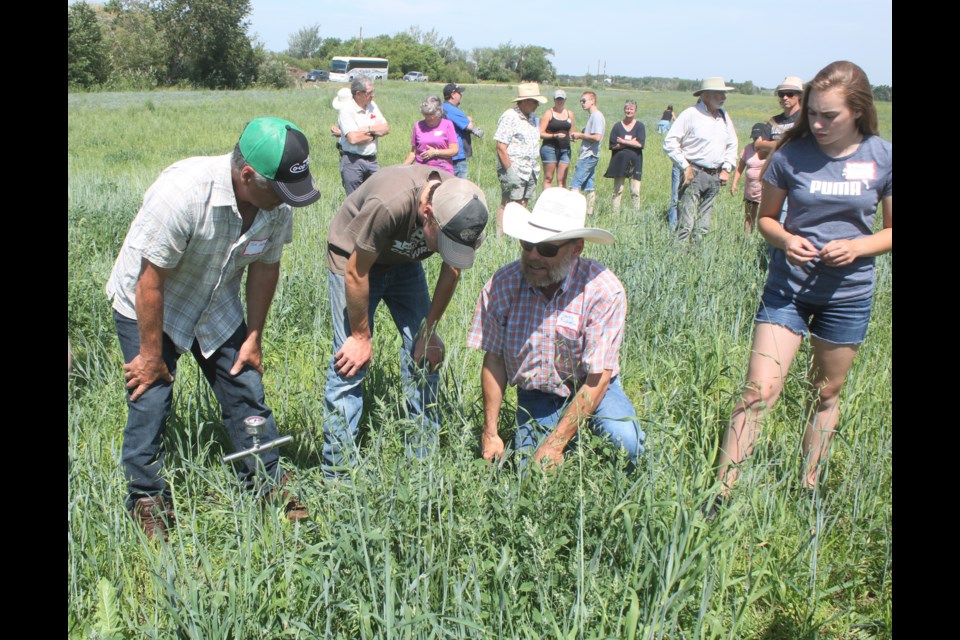Building the soil and reducing inputs is all part of what Garry Richards of Bangor terms regenerative-agriculture.
Wednesday Richards shared some of his thoughts on how to achieve the dual goals with those attending a field day held in the Bangor area. The day was arranged by Sask Organics and called ‘Covering Our Tracks’ focusing in the benefits of grazing with, or without owning livestock.
Garry, his wife Lynn, and their three children Rebekah, Evan, and Caroline have a mixed grain and cattle farm.
They came back to Garry’s family’s farm in 2000.
At that time Garry was a pharmacist, Lynn was a nurse, and Richards said in the first few years it was farming simply to determine whether or not the farm would be viable without long-term subsidies from off-farm income.
The farm was a straight grain operation in 2000, but beef cattle were added in 2002.
Then things changed as 15 years ago Richards said they took a holistic management course.
The course changed how they looked at the farm, getting them thinking about things such as the natural water and nutrient cycles of the soil. Coming to better understand the natural cycles began the process of changing how they farmed.
“In 2009 they started growing cover crop cocktails in an effort to become more sustainable,” noted the field day bio on the Richards. “One of their goals was to measure the changes they were making in the soil as a result of their regenerative management, so they now have lots of data on what is happening in their soil and are involved in a number of projects looking at soil health. They strive to integrate the cattle and grain enterprises on their farm to achieve healthy land, healthy people, and healthy profits.”
Richards said a key to the change was meeting Gabe Brown one of pioneersof the current soil health movement.
“I got to know him. He’s a great mentor,” said Richards.
But change without quantifiable results doesn’t mean a lot, admitted Richards who said as a pharmacist he wanted hard data “to see what kind of progress we’ve made,” he said.
While much of what Richards does follows practices that would be used by full organic producers, he is not fully organic, remaining willing to fertilizer or spray weeds on his 4200-acre farm, but only as a last resort.
“We’ve tried to minimize our chemical use, and we don’t use fungicides,” he said.
It’s a case of protecting the bugs in the soil.
“We do everything we can to make the microbes happy because they work for free and they work every day,” he said.
Still Richards said the farm is a no-till zone.
“I’m anti-tillage,” he said, adding tillage can have a negative effect on the soil in terms of its natural processes.
But weeds do need to be addressed.
Richards said he probably has eight different approaches to dealing with weeds with tillage number nine on the list, and herbicides number 10.
“I think weeds are a symptom of a deeper problem,” said Richards.
A favoured approach to dealing with weeds is to plant a diverse cover crop, which can be grazed, and after couple of years feeding cows can be direct seeded in with a disc drill to take a crop.
Richards admitted having 500 cows and 150 yearlings grazing “gives us options,” in terms of crop and weed management.
The key to a cover crop is having a mix of broadleaf and grass species, said Richards, adding that mimics what nature produces. He said he has found if you grow a grass crop, that would include cereal grains, nature will grow broadleaf weeds to balance things. If you grow a broadleaf crop, such as canola, grass weeds such as wild oats tend to flourish.
“Nature wants diversity,” he said. “... Diversity is the key. It’s the spice of life for soil, or for us.”
It’s not a perfect solution, admitted Richards.
“You’ve got to get a little used to weeds,” he said, adding it’s a case of coming to an understanding of “what’s acceptable.”

